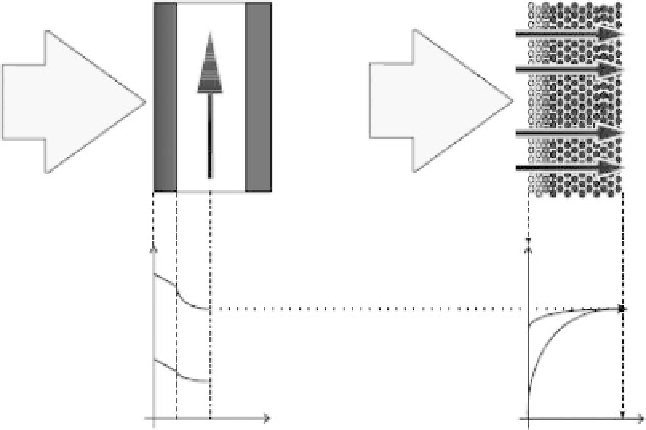Environmental Engineering Reference
In-Depth Information
Tube receiver
Volumetric receiver
Concentrated
solar radiation
~ 1000 kW/m
2
Concentrated
solar radiation
~ 200 kW/m
2
Gas
T
T
Exit
Absorber
Inlet
Inlet
Exit
Figure 14.3.19
Tubular receiver (left side) vs. volumetric receiver (right side) (Kreith and Goswami,
2007).
poor heat transfer coefficient. For this reason, a volumetric receiver, which is charac-
terized by a porous structure, increases the transfer surface, reducing the temperature
on the receiver even with gas fluids. The two options are shown in Figure 14.3.19.
The height of the receiver is usually in the range of 100-120 m. For example, the
centre of the receiver of the PS-10 tower is 100.5 m. In general, the taller the tower,
the higher the optical efficiency of the solar field since the cosine effect, shading and
blocking among heliostats are minimized. On the other hand, the cost of the tower
increases. It should be said that the tower is usually made of concrete. In addition
to these configurations, there is also a more exotic design where the tower acts as
secondary receiver and solar radiation is transferred to the fluid on the ground (see
Figure 14.3.20). This configuration penalizes the optical efficiency of the solar field
but reduces the cost of the tower since it has to support the secondary mirror instead
of the boiler, with advantages in terms of weight. An example of a beam-down concept
is the Tokyo Tech CSP project in Abu Dhabi (Beam-Down Solar Concentration).
The maximum temperature on the receiver depends on the particular heat transfer
fluid, the receiver technology and the power cycle adopted to convert the thermal
power into electricity. For example, the PS-10 plant is based on a saturated steam
boiler working at 250
◦
C and 40 bar. Different fluids have been investigated in order
to increase the temperature: molten salts have a maximum temperature of 565
◦
Casin
Gemasolar plant (ref), while air can go up to 800
◦
C. Suggested operating conditions
for tubular receivers are summarized in Table 14.3.3.

Search WWH ::

Custom Search